By: CS2113T T08-01 Since: Feb 2019 Licence: MIT
- 1. Introduction
- 2. Setting up
- 3. Design
- 4. Implementation
- 5. Documentation
- 6. Testing
- 7. Dev Ops
- Appendix A: Product Scope
- Appendix B: User Stories
- Appendix C: Use Cases
- Appendix D: Non Functional Requirements
- Appendix E: Glossary
- Appendix F: Product Survey
- Appendix G: Instructions for Manual Testing
1. Introduction
1.1. About VolunCHeer
VolunCHeer is an open-sourced Command Line Interface (CLI) management application designed for Volunteering Project Managers. We aim to help our target users alleviate the haystack of managing multiple projects, beneficiaries, and volunteers in an efficient and effective manner.
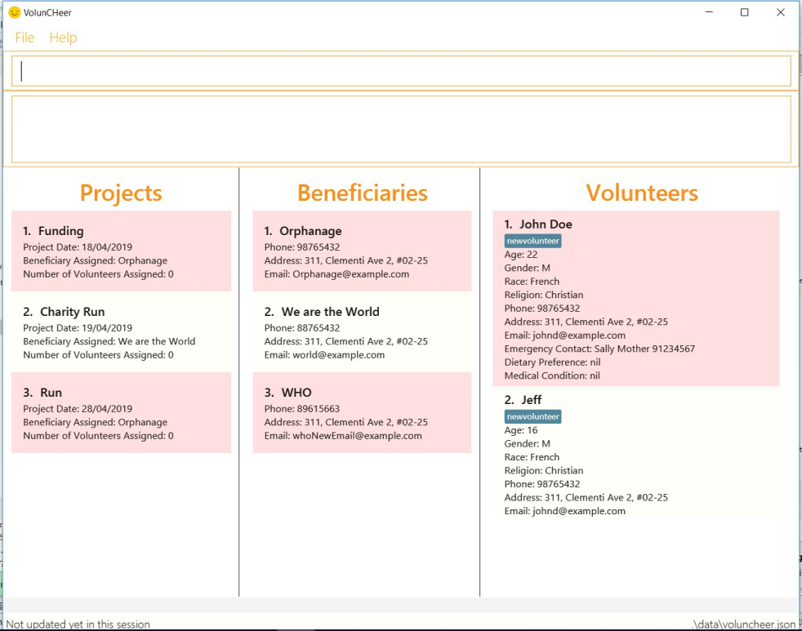
1.2. How to Contribute
There are lots of ways to contribute to VolunCHeer: coding, testing or improving our build process and tools. This developer’s guide provides information that will help you get started as a VolunCHeer contributor. Even if you are an experienced VolunCHeer developer, you will still find this guide to be useful to refer to.
If you are ready to contribute, simply create a Pull Request (PR) on our main repository.
If you have found any bugs or have ideas to improve VolunCHeer, create an issue here or contact us directly.
1.3. How to use this Developer Guide
| This is a note. A note contains considerations or notices when using VolunCHeer |
| This is a warning. Ensure not to violate these warnings when using VolunCHeer |
| This is a tip. A tip gives you suggestion on how to use certain features in VolunCHeer or how you can contribute to VolunCHeer |
2. Setting up
2.1. Prerequisites
-
JDK
9or laterJDK 10on Windows will fail to run tests in headless mode due to a JavaFX bug. Windows developers are highly recommended to use JDK9. -
IntelliJ IDE
IntelliJ by default has Gradle and JavaFx plugins installed.
Do not disable them. If you have disabled them, go toFile>Settings>Pluginsto re-enable them.
2.2. Setting up the project in your computer
-
Fork this repo, and clone the fork to your computer
-
Open IntelliJ (if you are not in the welcome screen, click
File>Close Projectto close the existing project dialog first) -
Set up the correct JDK version for Gradle
-
Click
Configure>Project Defaults>Project Structure -
Click
New…and find the directory of the JDK
-
-
Click
Import Project -
Locate the
build.gradlefile and select it. ClickOK -
Click
Open as Project -
Click
OKto accept the default settings -
Open a console and run the command
gradlew processResources(Mac/Linux:./gradlew processResources). It should finish with theBUILD SUCCESSFULmessage.
This will generate all resources required by the application and tests. -
Open
MainWindow.javaand check for any code errors-
Due to an ongoing issue with some of the newer versions of IntelliJ, code errors may be detected even if the project can be built and run successfully
-
To resolve this, place your cursor over any of the code section highlighted in red. Press ALT+ENTER, and select
Add '--add-modules=…' to module compiler optionsfor each error
-
-
Repeat this for the test folder as well (e.g. check
HelpWindowTest.javafor code errors, and if so, resolve it the same way)
2.3. Verifying the setup
-
Run the
seedu.voluncheer.MainApp -
Enter password (default: password)
-
Try a few commands
-
Run the tests to ensure they all pass.
2.4. Configurations to do before writing code
2.4.1. Configuring the coding style
This project follows oss-generic coding standards. IntelliJ’s default style is mostly compliant with ours but it uses a different import order from ours. To rectify,
-
Go to
File>Settings…(Windows/Linux), orIntelliJ IDEA>Preferences…(macOS) -
Select
Editor>Code Style>Java -
Click on the
Importstab to set the order-
For
Class count to use import with '*'andNames count to use static import with '*': Set to999to prevent IntelliJ from contracting the import statements -
For
Import Layout: The order isimport static all other imports,import java.*,import javax.*,import org.*,import com.*,import all other imports. Add a<blank line>between eachimport
-
Optionally, you can follow the UsingCheckstyle.adoc document to configure Intellij to check style-compliance as you write code.
3. Design
3.1. Architecture
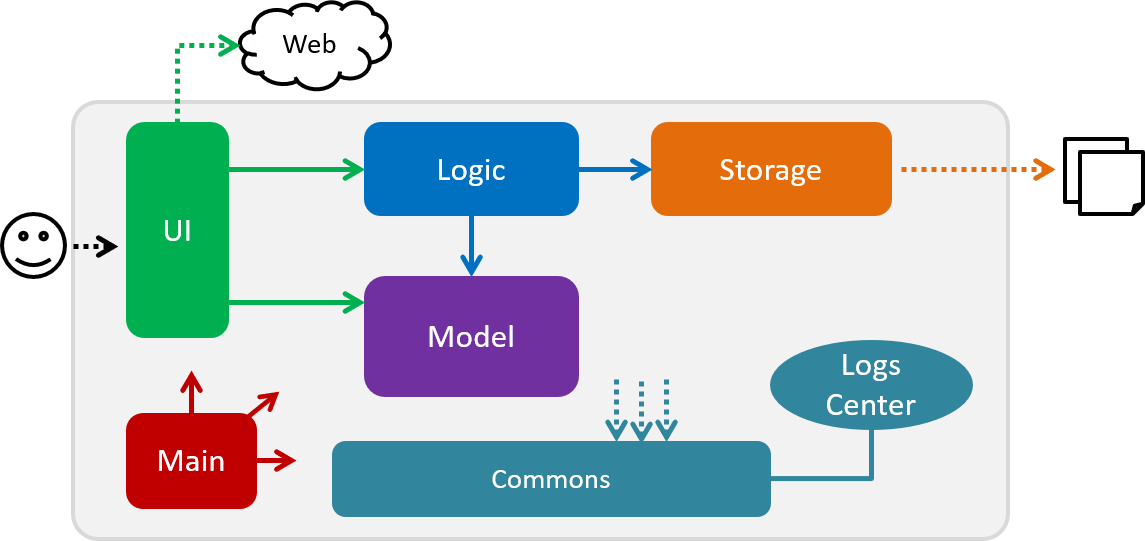
The Architecture Diagram given above explains the high-level design of the App. Given below is a quick overview of each component.
The .pptx files used to create diagrams in this document can be found in the diagrams folder. To update a diagram, modify the diagram in the pptx file, select the objects of the diagram, and choose Save as picture.
|
Main has only one class called MainApp. It is responsible for,
-
At app launch: Initializes the components in the correct sequence, and connects them up with each other.
-
At shut down: Shuts down the components and invokes cleanup method where necessary.
Commons represents a collection of classes used by multiple other components.
The following class plays an important role at the architecture level:
-
LogsCenter: Used by many classes to write log messages to the App’s log file.
The rest of the App consists of four components.
Each of the four components
-
Defines its API in an
interfacewith the same name as the Component. -
Exposes its functionality using a
{Component Name}Managerclass.
For example, the Logic component (see the class diagram given below) defines it’s API in the Logic.java interface and exposes its functionality using the LogicManager.java class.
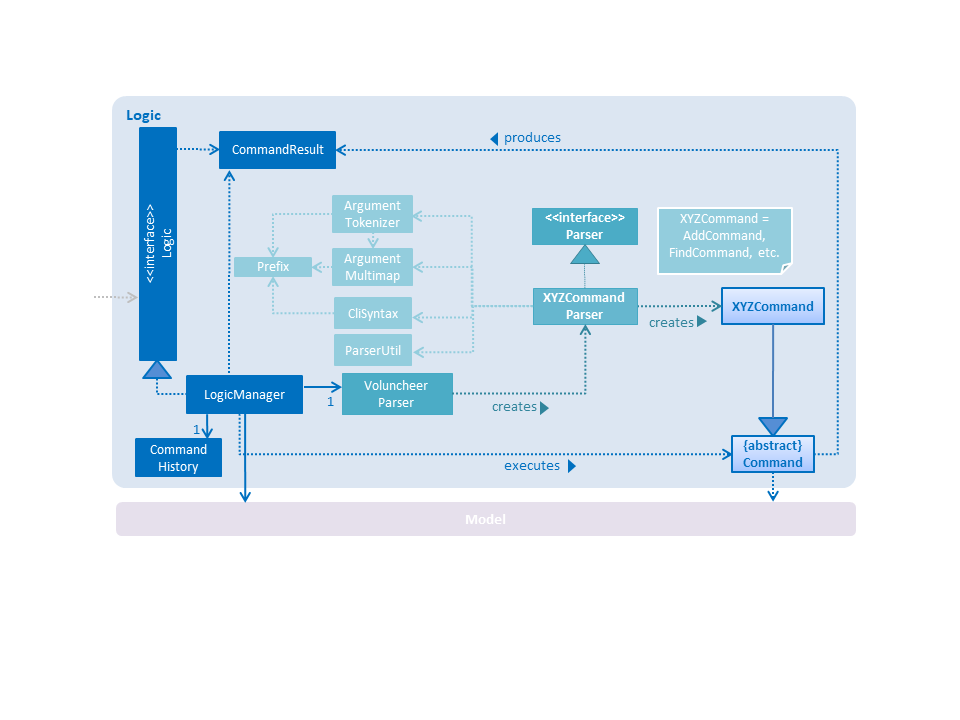
How the architecture components interact with each other
The Sequence Diagram below shows how the components interact with each other for the scenario where the user issues the command deleteVolunteer 1.
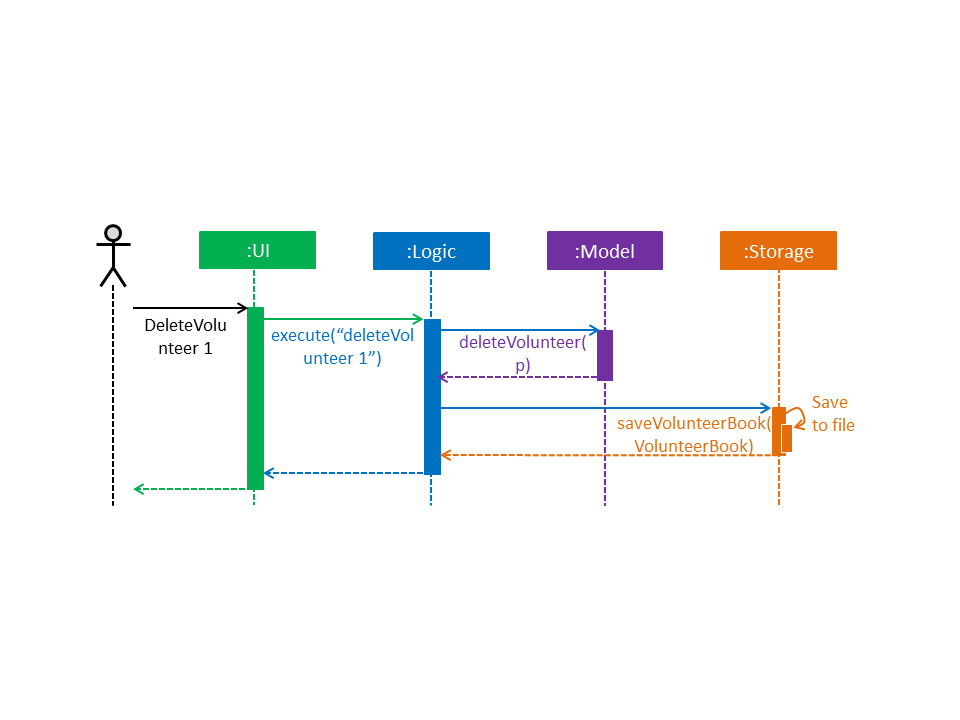
deleteVolunteer 1 commandThe sections below give more details of each component.
3.2. UI component
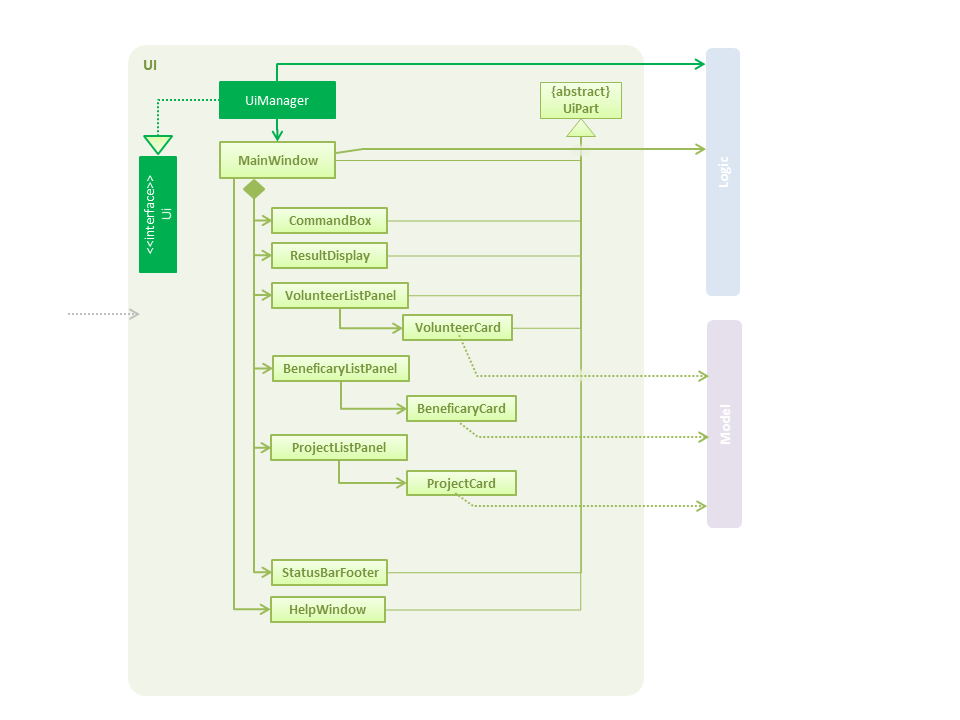
API : Ui.java
The UI consists of a MainWindow that is made up of parts e.g.CommandBox, ResultDisplay, StatusBarFooter, BrowserPanel etc. All these, including the MainWindow, inherit from the abstract UiPart class.
The UI component uses JavaFx UI framework. The layout of these UI parts are defined in matching .fxml files that are in the src/main/resources/view folder. For example, the layout of the MainWindow is specified in MainWindow.fxml
The UI component,
-
Executes user commands using the
Logiccomponent. -
Listens for changes to
Modeldata so that the UI can be updated with the modified data.
3.3. Logic component

API :
Logic.java
-
Logicuses theVolunCHeerParserclass to parse the user command. -
This results in a
Commandobject which is executed by theLogicManager. -
The command execution can affect the
Model(e.g. adding a volunteer). -
The result of the command execution is encapsulated as a
CommandResultobject which is passed back to theUi. -
In addition, the
CommandResultobject can also instruct theUito perform certain actions, such as displaying help to the user.
3.4. Model component
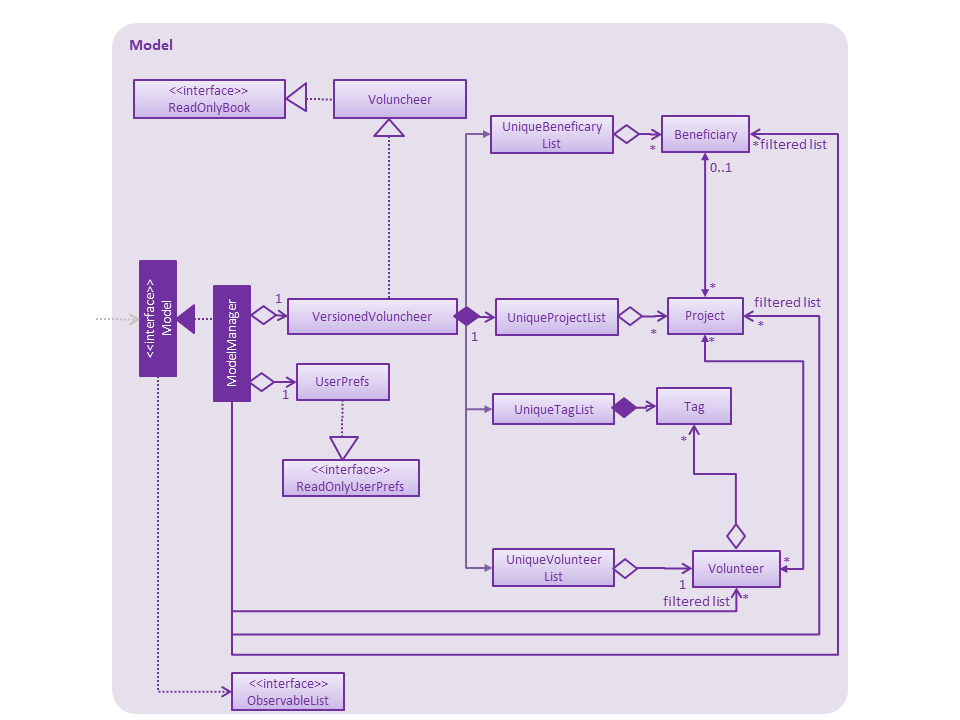
API : Model.java
The Model,
-
stores a
UserPrefobject that represents the user’s preferences. -
stores the Volunteer Book, Beneficiary Book, Project Book data.
-
manages the interaction and relationship between different objects (Volunteer, Beneficiary, Project)
-
exposes an unmodifiable
ObservableList<Object>that can be 'observed' (Object can be Vounteer, Beneficiary, Project). e.g. the UI can be bound to this list so that the UI automatically updates when the data in the list change. -
does not depend on any of the other three components.
3.5. Storage component
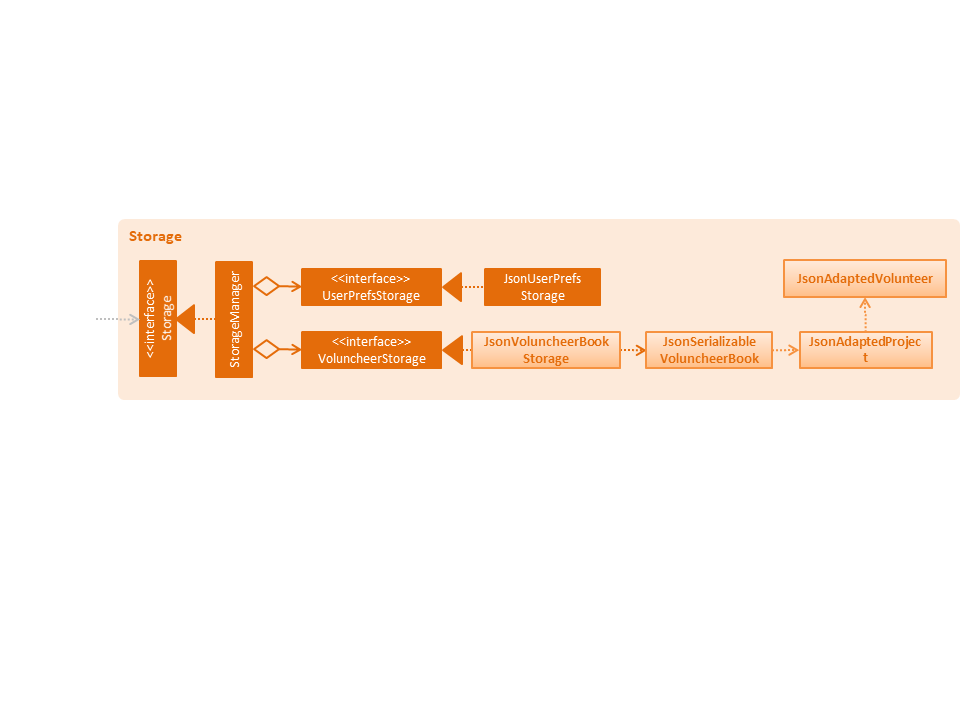
API : Storage.java
The Storage component,
-
can save
UserPrefobjects in json format and read it back. -
can save the VolunCHeer Book data in json format and read it back.
3.6. Common classes
Classes used by multiple components are in the seedu.voluncheerbook.commons package.
4. Implementation
4.1. Password Feature
4.1.1. Current Implementation
A password is required to grant access to the project manager at the start of the program. It serves as a security mechanism to protect the important data within.
At the start of the program, the UI is initialised by UiManager. A password window will pop out and prompt the user
to enter the password.

The password feature uses ValidatePassword to check if the user input matches the password stored in the program.
If the password matches, it will set boolean user to be true. UiManager will thus instantiate
fillInnerParts(), displaying the hidden data to the project manager.
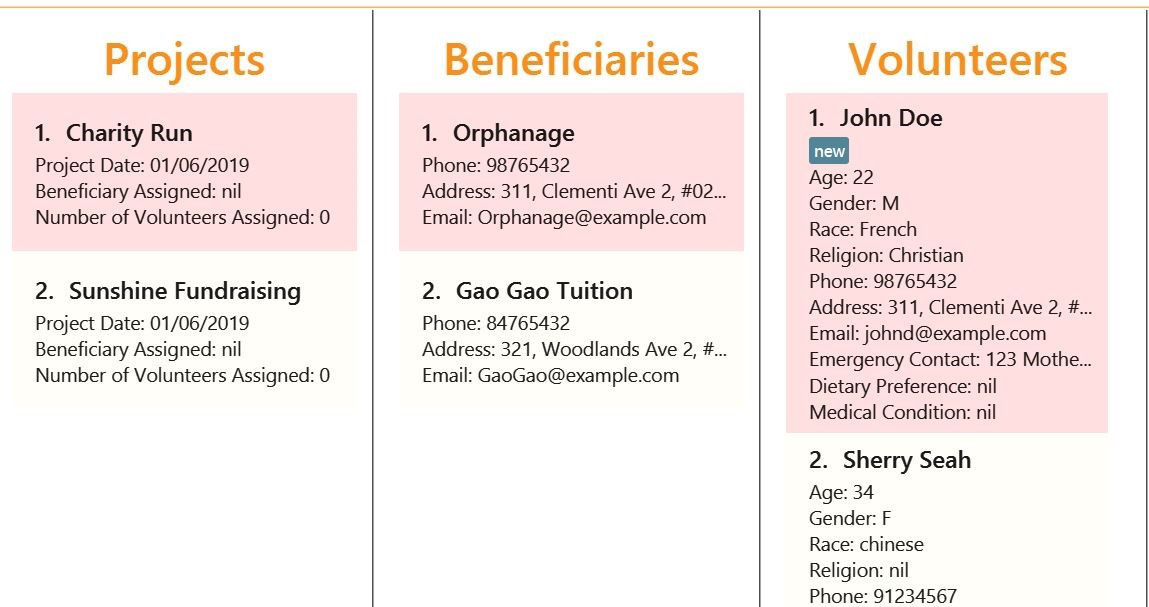
If the password is entered incorrectly for five times, the program will terminate itself. A sequence diagram is shown below to illustrate how it works in an abstract level.
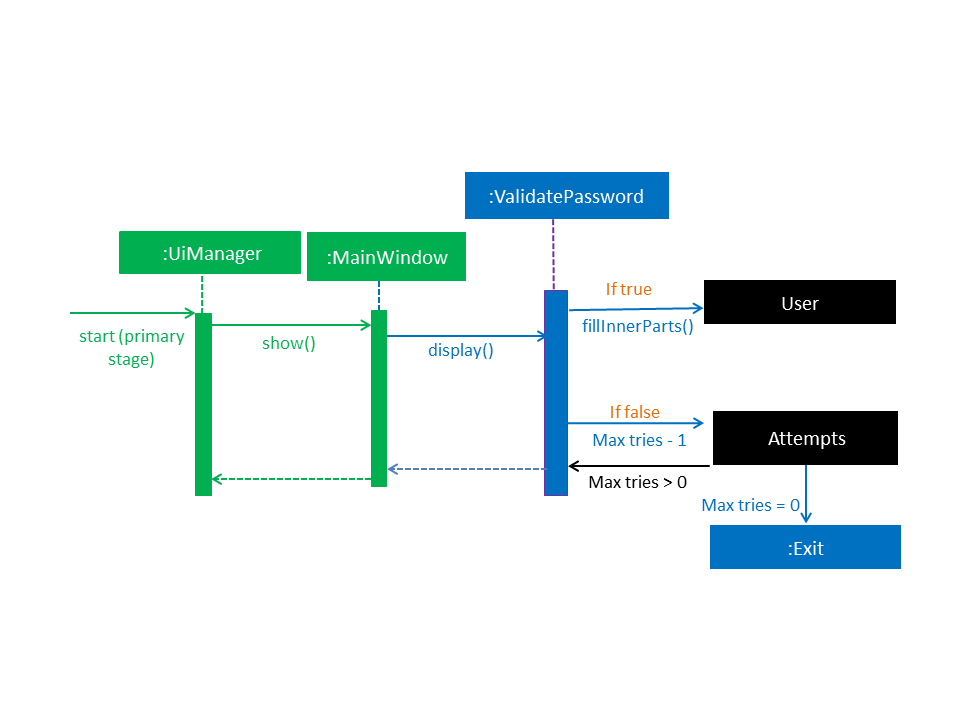
4.1.2. Design Considerations
| Aspect | Alternatives | Pros (+)/ Cons(-) |
|---|---|---|
Implementation of Synchronization |
UI with a password field. (current choice) |
+ : It is simple and user friendly. It serves its purpose as a offline application for a single user.
|
Using Command Line Interface |
+ : It allows more flexibility to implement more parameters such as custom security questions to improve its security. |
This section describes some noteworthy details on how certain features are implemented.
4.2. Project Complete Feature
The complete feature allows users to indicate a project as completed.
4.2.1. Implementation
To facilitate the complete feature, an association with a new Complete class is added to the Project class:
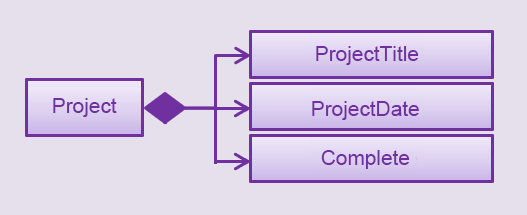
The diagram shows that the Project class is associated with the Complete class.
The following sequence diagram shows how the complete command works:
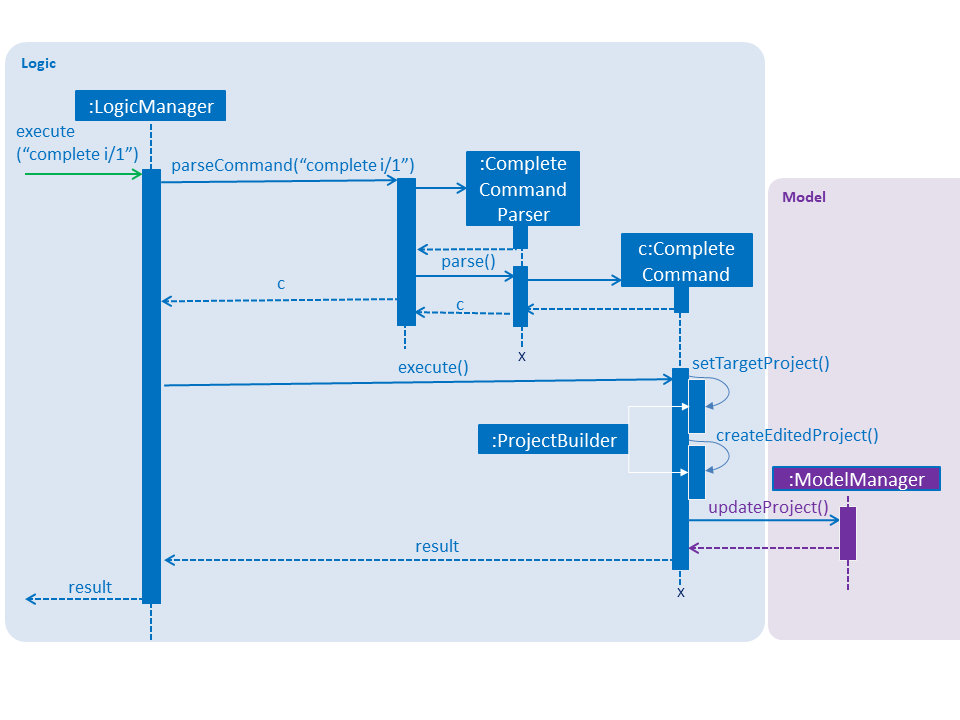
-
The
CompleteCommandParserparses the user input to obtain the target project index and constructs a neCompleteCommandwith this index. -
The logic portion of the complete command will be executed by the
CompleteCommandmethod. To mark a Project object as complete:-
The CompleteCommand() method creates a
targetProjectbased on the provided project index. -
In the executeCommandResult() method then creates a
editedProjectwithCompleteattribute set to “true”. TheeditedProjectis created with ProjectBuilder as shown below:
-
Project editedProject = new ProjectBuilder(targetProject).withComplete(true).build();-
In the executeCommandResult() method
model.setProject(targetProject, editedProject)is called to replace Project’s complete attribute from “false” to “true” in the VolunCHeer in-memory.
4.2.2. Design Considerations
| Aspect | Alternatives | Pros (+)/ Cons(-) |
|---|---|---|
Implementation of ‘CompleteCommand’ |
Add a Complete attribute to Project (current choice) -Completed projects indicated “Red” |
+ : It is easy to tag complete status as an attribute to the |
Create a new CompletedProjectList that consists of all the complete projects, a listComplete command to show all completed tasks.. |
+ : Will use less memory (e.g. for deleteVolunteer, just save the volunteer being deleted).
|
4.3. Assign Feature
Assigning a Beneficiary / VolunteerList to Project.
4.3.1. Implementations
Since the implementation of commands AssignBeneficiary and AssignVolunteer are similar, we will describe the implementation of AssignBeneficiary command only and provide the difference between the two.
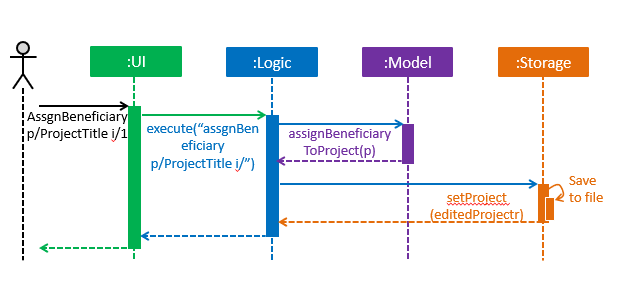
-
The AssignBeneficiaryCommand(ProjectTitle, Index) takes in the targetProject’s projectTitle attribute and targetBeneficiary’s index.
-
The executeCommandResult() method
-
Sets up projectToAssign by calling a predicate to compare with the
ProjectTitleinFilteredProjectList:model. getFilteredProjectList(). filtered(equalProjectTitle).get(0);
-
updateBeneficiary(model) methods updates the
Beneficiaryobject so that ProjectTitle is tracked within the Beneficiary class. -
editedProject is created using ProjectBuilder to take in the
Beneficiaryassigned. The following method is called to store theProjectin VolunCHeer with specificBeneficiaryattached to it.model.setProject(projectToAssign, editedProject)
-
4.4. Beneficiary Management Feature
4.4.1. Implementation
Beneficiary is implement in order to manage the information a benefited volunteer organization. These organizations interact
with the user’s organization through projects. Hence, Beneficiary class has a bidirectional navigability with Project class,
as shown in the Figure 10.
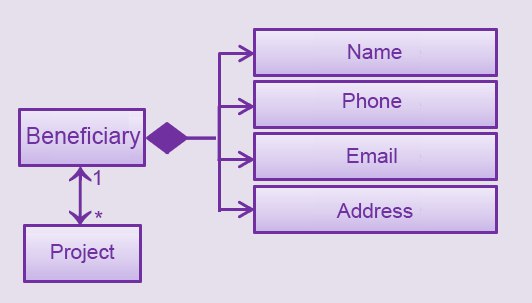
Beneficiary class including its attributes, and its bidirectional navigability with Project class.This means that if an operation such as deletion is done on a beneficiary, this should be updated on the projects that the beneficiary is assigned to. The figure below shows how the delete beneficiary command works:
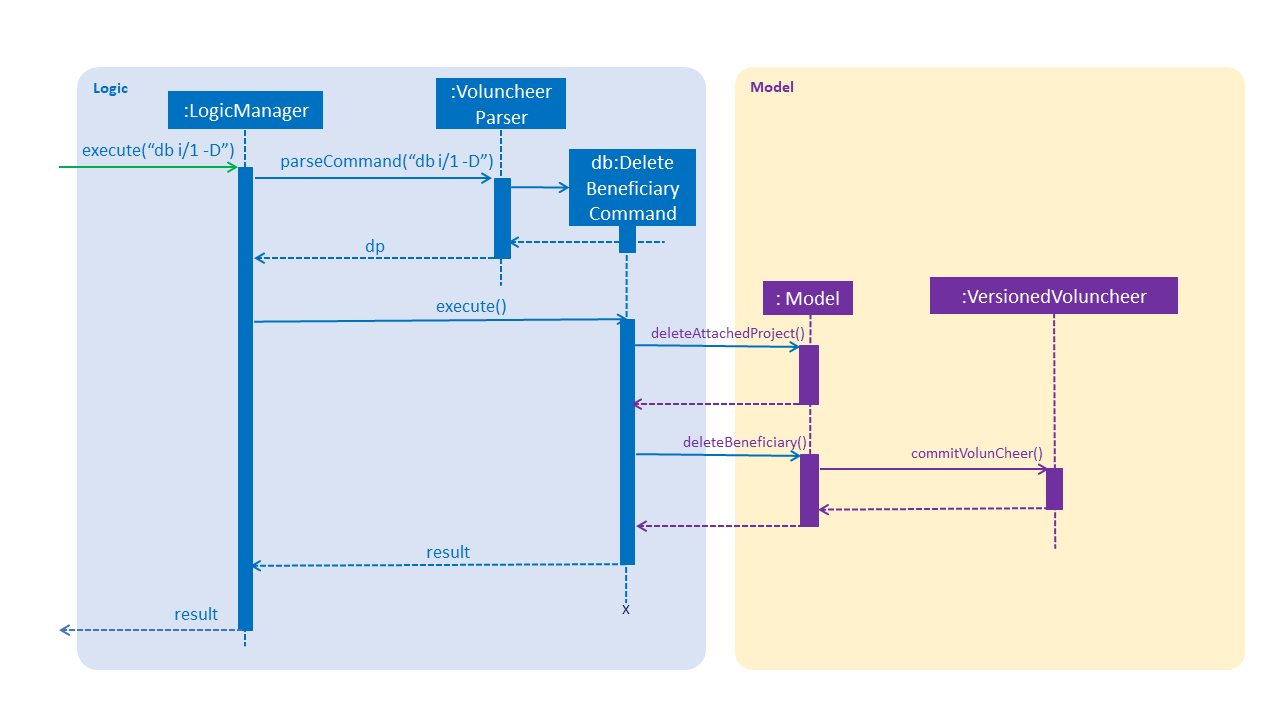
| "-D" indicates that the deletion is in the hard mode, meaning that the respective projects that are attached to this beneficiary will be deleted. |
-
The
DeleteBeneficiaryParserparses the index of the beneficiary that is required to delete. The Parser constructs aDeleteBeneficiaryCommandwith constructor as shown below:
public DeleteBeneficiaryCommand(Index targetIndex, boolean isHardDeleteMode) {
this.targetIndex = targetIndex;
this.isHardDeleteMode = isHardDeleteMode;
}-
Method deleteAttachedProjects(model, beneficiaryToDelete) then calls the
ModelManagerto update the deletion of the respective projects.
private void deleteAttachedProjects(Model model, Beneficiary beneficiaryToDelete) {
HashSet<ProjectTitle> attachedProjects = beneficiaryToDelete.getHashAttachedProjectLists();
List<Project> projectsToDelete = new ArrayList<>(model.getFilteredProjectList());
for (Project p : projectsToDelete) {
if (attachedProjects.contains(p.getProjectTitle())) {
model.deleteProject(p);
}
}
}-
The
ModelManageris then called to update the deletion of the beneficiary and update all the changes.
model.deleteBeneficiary(beneficiaryToDelete);
model.commitAddressBook();In order to view the synchronization, you can observe via project pool. This is to alleviate the worries of looking at attached projects
when dealing with beneficiary, as a beneficiary can have multiple projects.
However, the Beneficiary Management Feature support the viewing of these information via Summarise Command. The Summarise Command generates
the summarised statistics information of beneficiary based on their activeness.
| The activeness of a beneficiary is measured by the number of projects that beneficiary has collaborated with the user’s organization |
The sequence diagram below shows how the Summarise Command works.
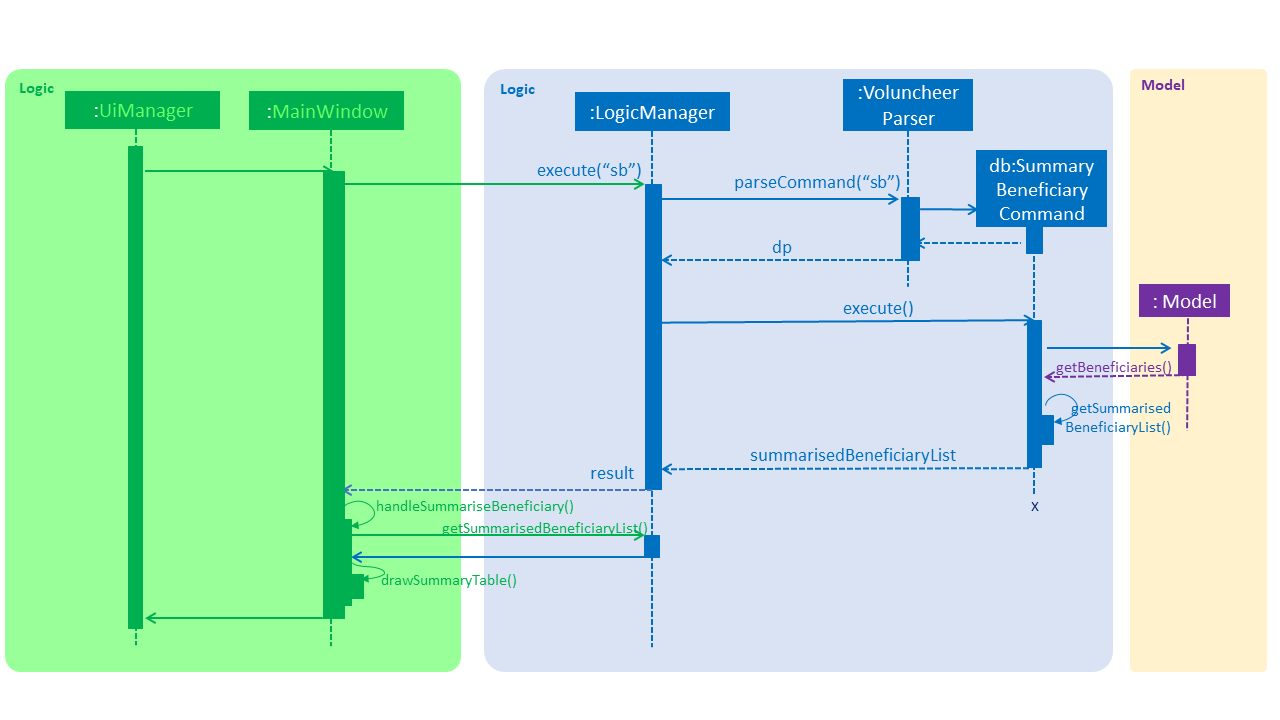
-
SummaryBeneficiaryCommandcalls theModelto get the beneficiary list. -
A summary list is generated and passed to
Logic. -
The Ui component which is
MainWindowdoes handling of summarised list by generate a summary table and show on the screen.
4.4.2. Design Considerations
| Aspect | Alternatives | Pros (+)/ Cons(-) |
|---|---|---|
Implementation of Synchronization |
Update the by linear search for designed object |
+ : It is easier to implement because the code base are list based. Moreover, the use of the application is limited to only local
use without a large amount of data. Hence, this method gives a good performance in the context. |
Hash Table of the data |
+ : It has a better time complexity and reduce the work in scaling stage since this data structure is more optimized (O(1) can be achieved). |
|
Display and use of attached project list |
The beneficiary card shows the list |
+ : The synchronization can be observed throughout the execution of commands. |
Generation of summary table |
+ : The summary gives a good way to look at the statistics of the beneficiary list. As it allows the dynamic of sorting in ascending or descending order
of the list based on the beneficiary’s activeness |
4.5. Filtered Export feature
4.5.1. Current Implementation
To facilitate the filtering mechanism, a new points integer field is added to the Volunteer class:
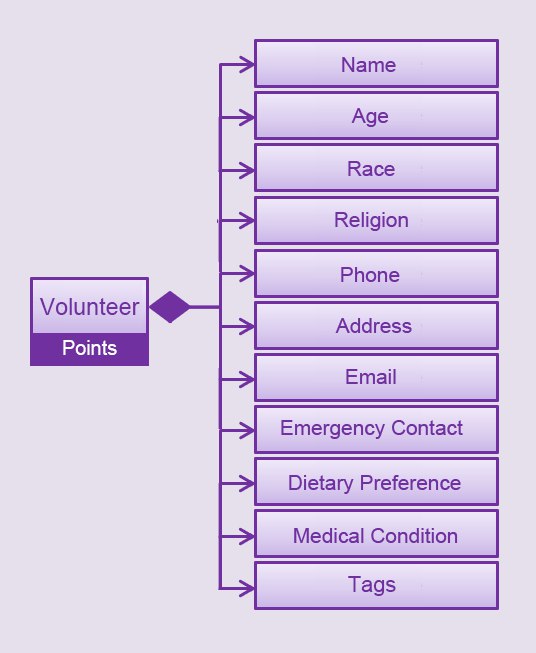
Points was implemented as a integer instead of a class for ease of access. Also, it is not directly influenced by
any input from the user, as input has been checked by the the other classes in Volunteer. Hence, no accompanying
methods are necessary.
This feature revolves around 3 commands:
-
mapCommand -
sortCommand -
exportVCommand
For the map command, the user inputs the specific criteria to map Volunteers on, as well as the points.
Upon execution of the map command, the following sequence diagram shows how the map command works:
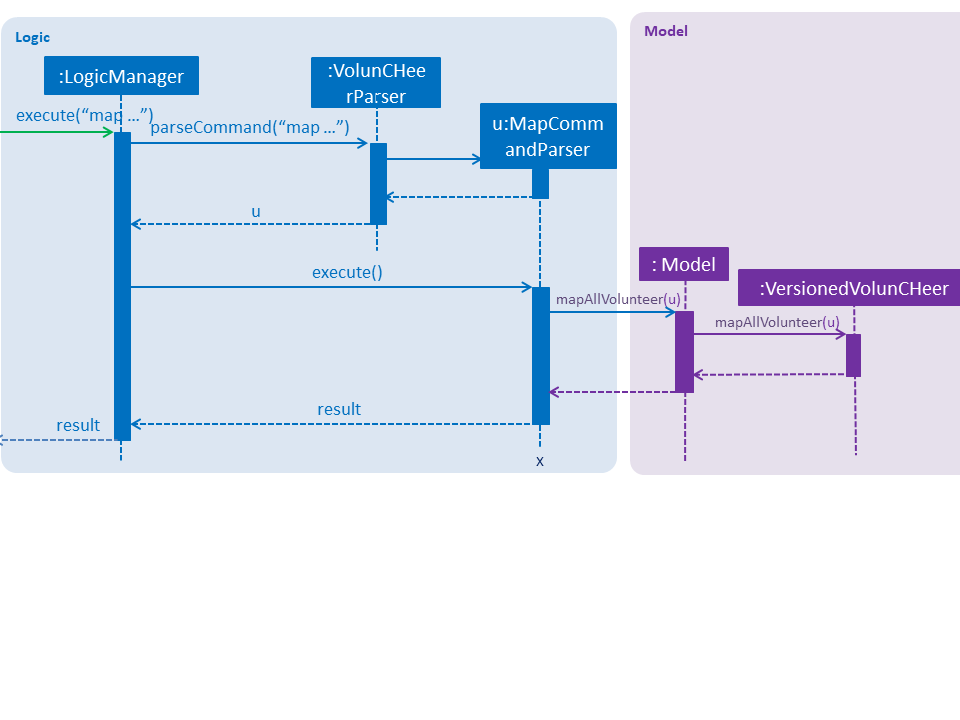
MapCommandParser will check the given arguments for correctness, such as proper points or valid comparator.
It then creates a MapObject and stores the given arguments in a Pair of <points, conditions> and passes it to MapCommand, which passes it to Model
by calling mapAllVolunteers.
Within the model, mapAllVolunteers() is as shown:
public void mapAllVolunteer(MapObject map) {
versionedAddressBook.getVolunteerList().forEach(volunteer -> {
volunteer.resetPoints();
volunteer.addPoints(checkAge(map, volunteer));
volunteer.addPoints(checkRace(map, volunteer));
volunteer.addPoints(checkMedical(map, volunteer));;
});
}The checkAge, checkRace and checkMedical methods check each Volunteer and
return the given points for that criteria,
which addPoints adds to them.
Sort Command
For the Sort command, the Model calls the UniqueVolunteerList internal sortByPoints method.
This method uses the standard FXCollections.sort on the internalList,
which immediately reflects in the UI.
public void sortByPoints() {
FXCollections.sort(internalList, (new Comparator<Volunteer>() {
public int compare (Volunteer s1, Volunteer s2) {
return s2.getPoints() - s1.getPoints();
}
}));
}The custom comparator sorts Volunteers in descending order of points.
Export Command
The exportV command writes certain parts of volunteers data based on provided crtieria.
It takes on various parameters such as [NUMBER OF VOLUNTEERS],
[PREFIX OF DATA REQUIRED 1][PREFIX OF DATA REQUIRED 2] … .
The ExportVolunteerCommandParser checks that at least 1 type of data and the number of Volunteers
is given. It then stores the prefixes in a list called prefixToBePrinted and returns the the list and the number of volunteers
as a Pair to ExportVolunteer.
The code snippet below shows how the main command is implemented.
File output = new File("Export.csv");
List<String[]> volunteerData = new ArrayList<>();
volunteerData = model.addData(numVolunteers, prefixToBePrinted);
try (PrintWriter pw = new PrintWriter(output)) {
volunteerData.stream()
.map(this::toCsv)
.forEach(pw::println);
} catch (IOException e) {
throw new CommandException("Error writing to file");
}A List of String arrays is used to store each line of Volunteer. The addData method goes through the Volunteer
list and collects the specified fields into a String array, which is appended to another List of String arrays
and returned. The toCsv method formats the data into CSV-friendly data.
Below are certain considerations made when designing the filtered export feature.
| Aspect | Alternatives | Pros (+)/ Cons(-) |
|---|---|---|
Sorting the internal volunteer list |
Using a SortedList wrapper around the unmodifiable list |
+ : Easy to implement. + Will not affect the actual data.
|
Using PrintWriter to write out data to CSV |
Using an open-source library such as openCSV to handle the writing. |
+ : Easier to understand and code for any new developers. + openCSV will handle special characters in data.
|
4.6. Undo/Redo feature
4.6.1. Current Implementation
The undo/redo mechanism is facilitated by VersionedVolunCHeer.
It extends VolunCHeer with an undo/redo history, stored internally as an voluncheerBookStateList and currentStatePointer.
Additionally, it implements the following operations:
-
VersionedVolunCHeer#commit()— Saves the current VolunCHeer book state in its history. -
VersionedVolunCHeer#undo()— Restores the previous VolunCHeer book state from its history. -
VersionedVolunCHeer#redo()— Restores a previously undone VolunCHeer book state from its history.
These operations are exposed in the Model interface as Model#commitVolunCHeer(), Model#undoVolunCHeer() and Model#redoVolunCHeer() respectively.
Given below is an example usage scenario and how the undo/redo mechanism behaves at each step.
Step 1. The user launches the application for the first time. The VersionedVolunCHeer will be initialized with the initial VolunCHeer book state, and the currentStatePointer pointing to that single VolunCHeer book state.
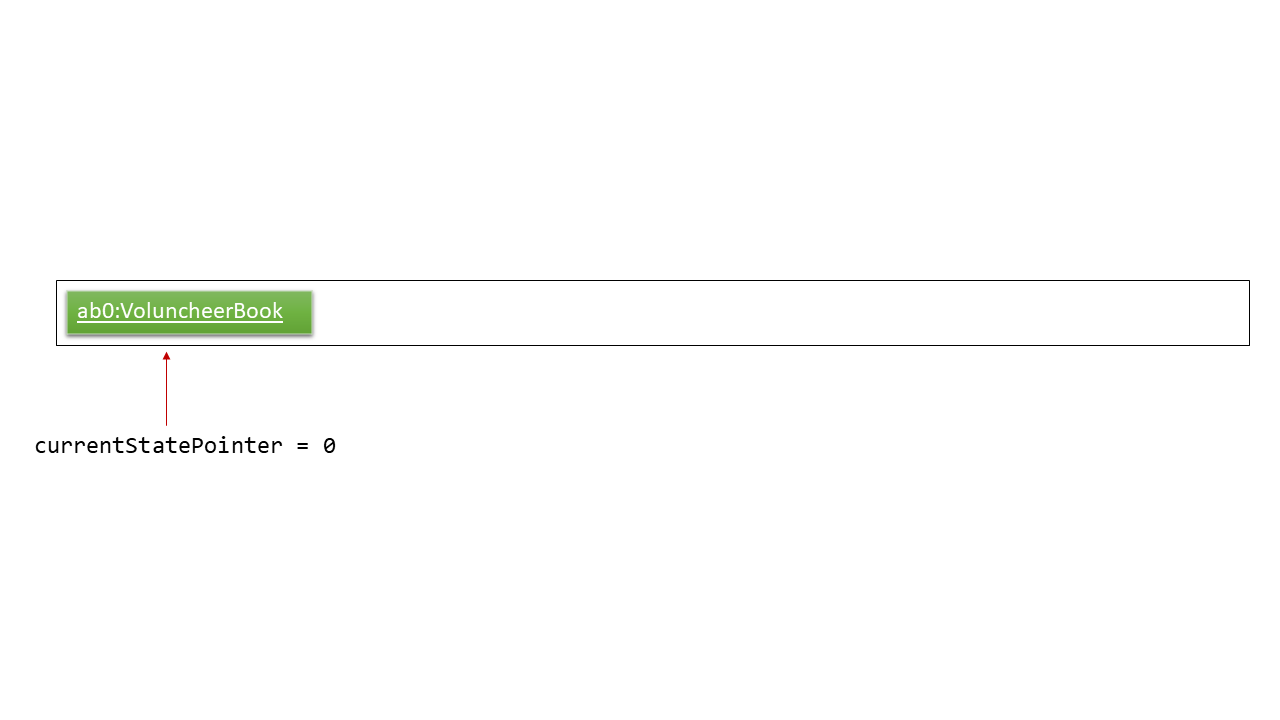
Step 2. The user executes deleteVolunteer 5 command to delete the 5th Volunteer in the VolunCHeer book. The deleteVolunteer command calls Model#commitVolunCHeer(), causing the modified state of the VolunCHeer book after the delete 5 command executes to be saved in the VolunCHeerStateList, and the currentStatePointer is shifted to the newly inserted VolunCHeer book state.
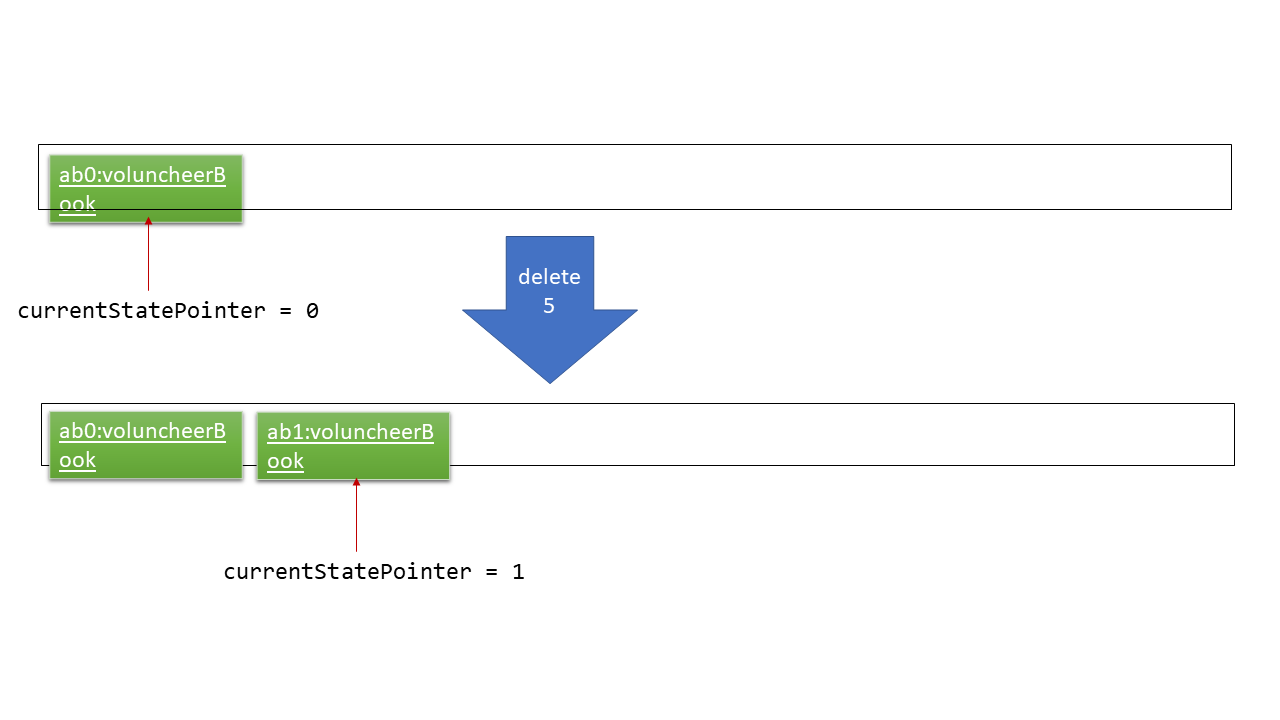
Step 3. The user executes add n/David … to add a new volunteer. The add command also calls Model#commitVolunCHeer(), causing another modified VolunCHeer book state to be saved into the VolunCHeerStateList.
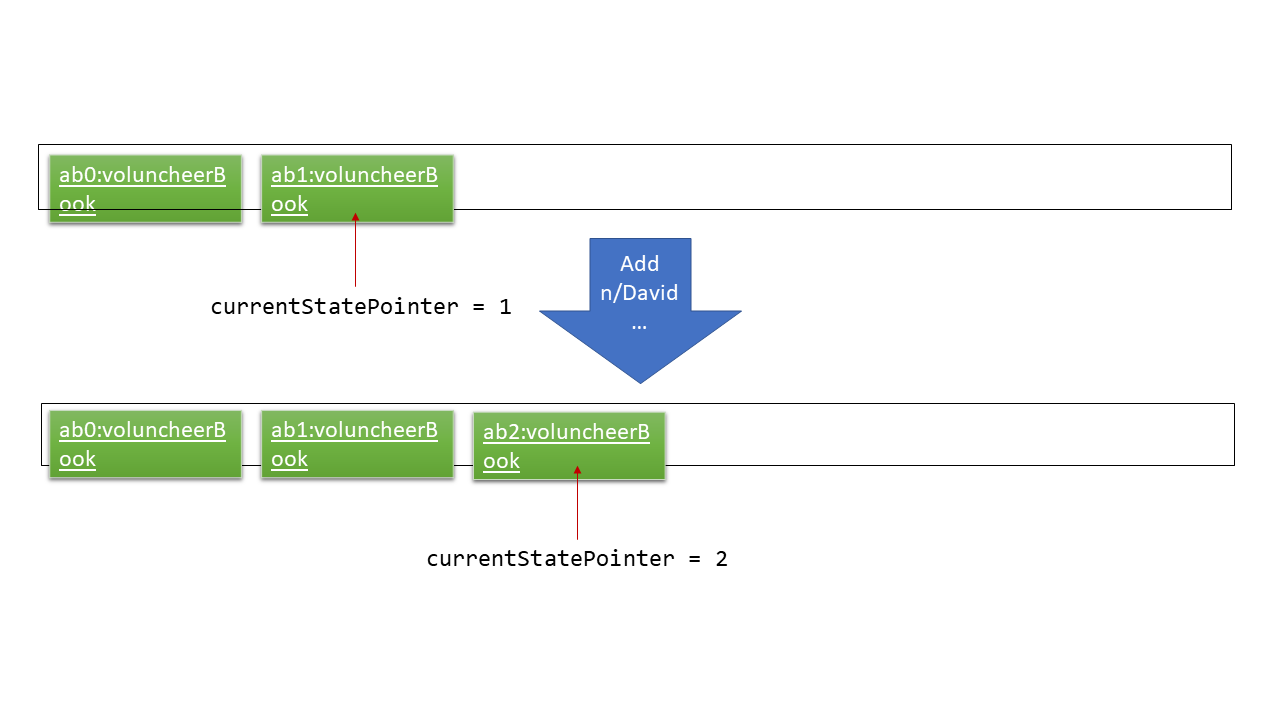
If a command fails its execution, it will not call Model#commitVolunCHeer(), so the VolunCHeer book state will not be saved into the VolunCHeerStateList.
|
Step 4. The user now decides that adding the volunteer was a mistake, and decides to undo that action by executing the undo command. The undo command will call Model#undoVolunCHeer(), which will shift the currentStatePointer once to the left, pointing it to the previous VolunCHeer book state, and restores the VolunCHeer book to that state.
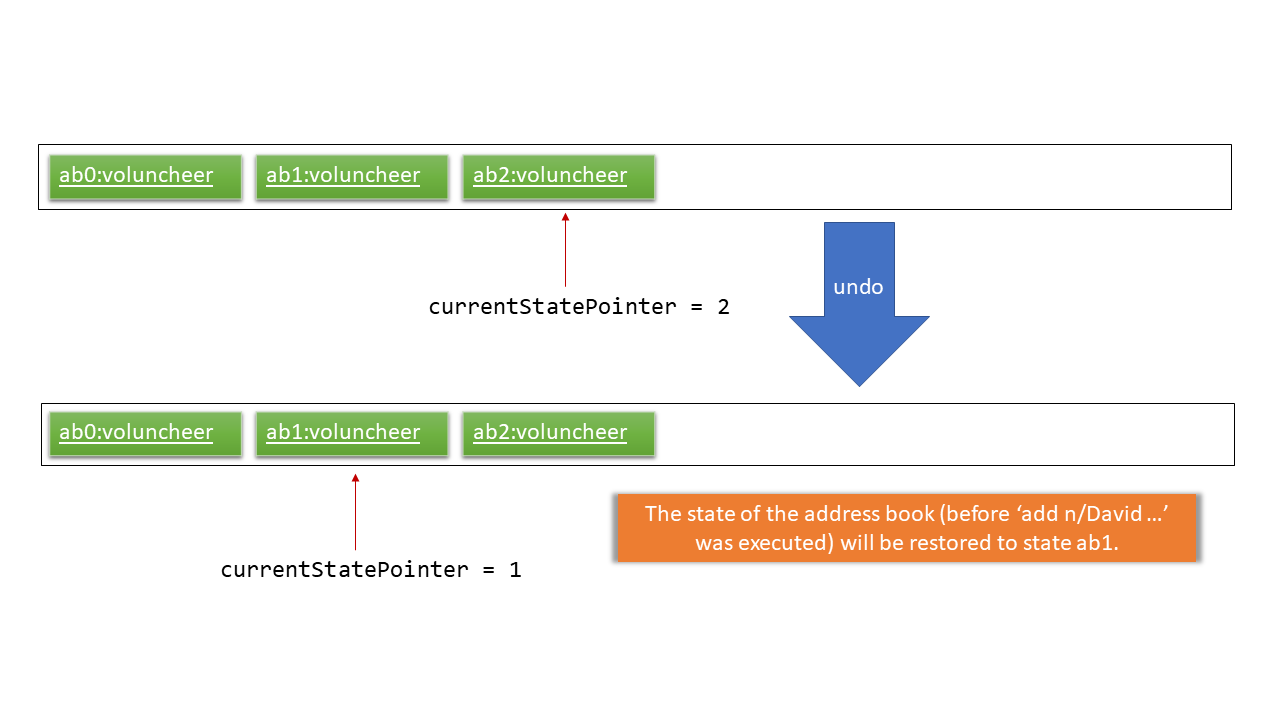
If the currentStatePointer is at index 0, pointing to the initial VolunCHeer book state, then there are no previous VolunCHeer book states to restore. The undo command uses Model#canUndoVolunCHeer() to check if this is the case. If so, it will return an error to the user rather than attempting to perform the undo.
|
The following sequence diagram shows how the undo operation works:
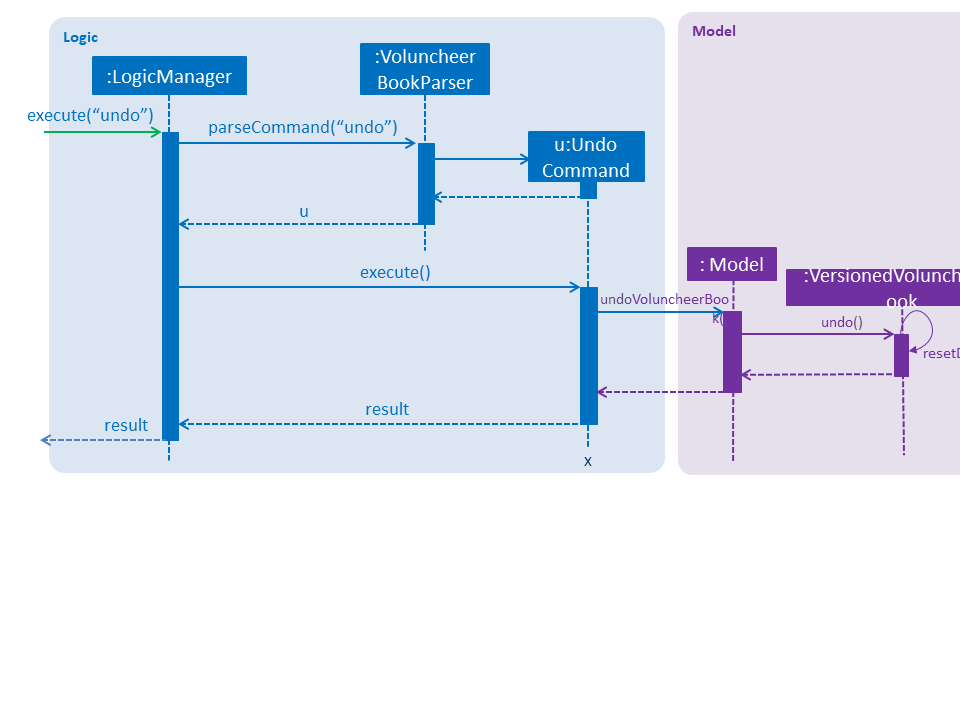
The redo command does the opposite — it calls Model#redoVolunCHeer(), which shifts the currentStatePointer once to the right, pointing to the previously undone state, and restores the VolunCHeer book to that state.
If the currentStatePointer is at index VolunCHeerStateList.size() - 1, pointing to the latest VolunCHeer book state, then there are no undone VolunCHeer book states to restore. The redo command uses Model#canRedoVolunCHeer() to check if this is the case. If so, it will return an error to the user rather than attempting to perform the redo.
|
Step 5. The user then decides to execute the command list. Commands that do not modify the VolunCHeer book, such as list, will usually not call Model#commitVolunCHeer(), Model#undoVolunCHeer() or Model#redoVolunCHeer(). Thus, the VolunCHeerStateList remains unchanged.
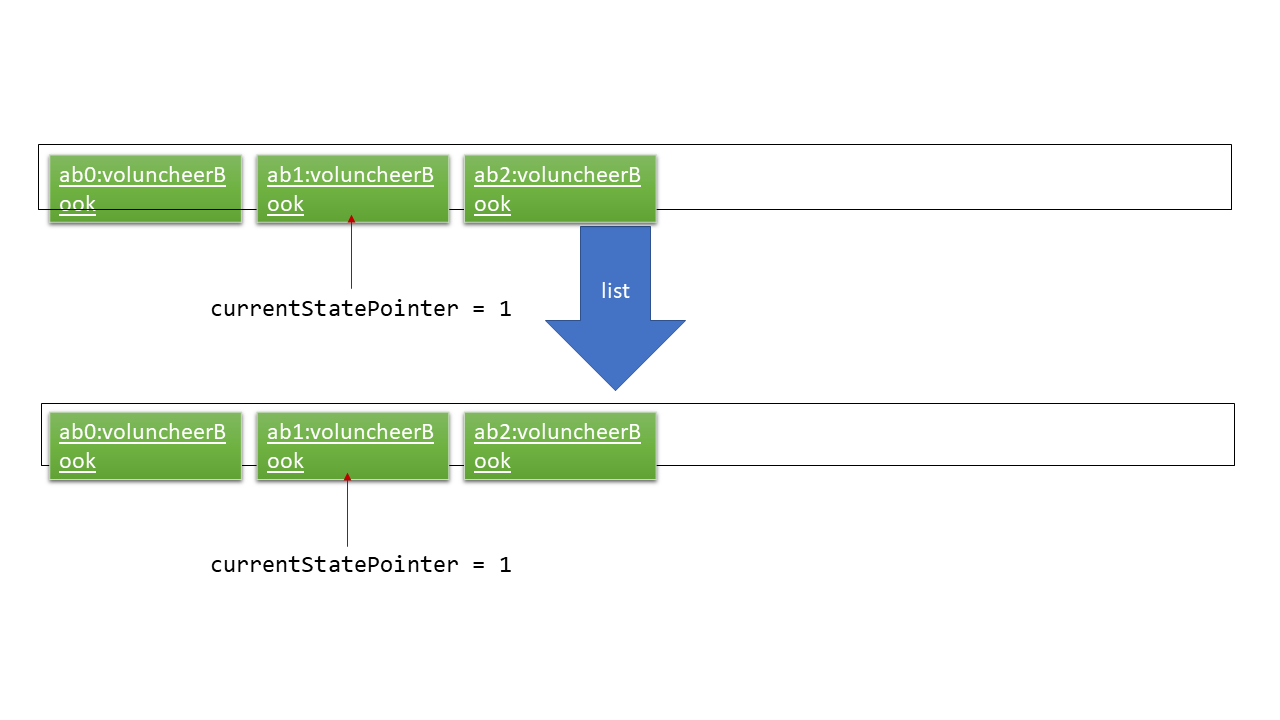
Step 6. The user executes clear, which calls Model#commitVolunCHeer(). Since the currentStatePointer is not pointing at the end of the VolunCHeerStateList, all VolunCHeer book states after the currentStatePointer will be purged. We designed it this way because it no longer makes sense to redo the add n/David … command. This is the behavior that most modern desktop applications follow.

The following activity diagram summarizes what happens when a user executes a new command:
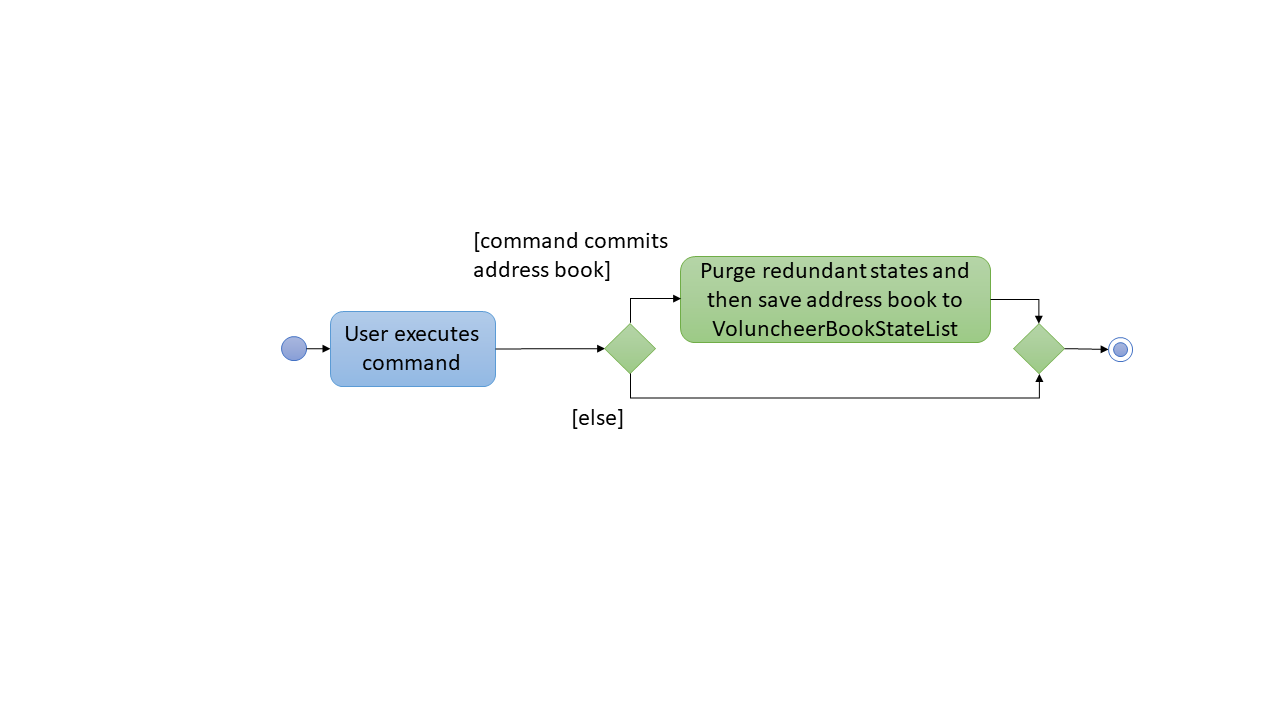
4.6.2. Design Considerations
| Aspect | Alternatives | Pros (+)/ Cons(-) |
|---|---|---|
How undo & redo executes |
Saves the entire VolunCHeer book. |
+ : Easy to implement. |
Individual command knows how to undo/redo by itself. |
+ : Will use less memory (e.g. for |
|
Data structure to support the undo/redo commands |
Use a list to store the history of VolunCHeer book states. |
+ : Easy for new Computer Science student undergraduates to understand, who are likely to be the new incoming developers of our project.+
|
Use |
+ : We do not need to maintain a separate list, and just reuse what is already in the codebase. |
4.7. [Proposed] Project Calendar
_{The projectcalendar mechanism takes the projectTitle and projectDate attribute of the project list and apply them into - Google Calendar API such that the UI now includes a calendar interface and projects sorted according to date. The API has a dependency on Google API Client Library and build.gradle file compiles 'com.google.api-client:google-api-client:1.25.0'.
4.8. Logging
We are using java.util.logging package for logging. The LogsCenter class is used to manage the logging levels and logging destinations.
-
The logging level can be controlled using the
logLevelsetting in the configuration file (See Section 4.9, “Configuration”) -
The
Loggerfor a class can be obtained usingLogsCenter.getLogger(Class)which will log messages according to the specified logging level -
Currently log messages are output through:
Consoleand to a.logfile.
Logging Levels
-
SEVERE: Critical problem detected which may possibly cause the termination of the application -
WARNING: Can continue, but with caution -
INFO: Information showing the noteworthy actions by the App -
FINE: Details that is not usually noteworthy but may be useful in debugging e.g. print the actual list instead of just its size
4.9. Configuration
Certain properties of the application can be controlled (e.g user prefs file location, logging level) through the configuration file (default: config.json).
5. Documentation
We use asciidoc for writing documentation.
| We chose asciidoc over Markdown because asciidoc, although a bit more complex than Markdown, provides more flexibility in formatting. |
5.1. Editing Documentation
See UsingGradle.adoc to learn how to render .adoc files locally to preview the end result of your edits.
Alternatively, you can download the AsciiDoc plugin for IntelliJ, which allows you to preview the changes you have made to your .adoc files in real-time.
5.2. Publishing Documentation
See UsingTravis.adoc to learn how to deploy GitHub Pages using Travis.
5.3. Converting Documentation to PDF format
We use Google Chrome for converting documentation to PDF format, as Chrome’s PDF engine preserves hyperlinks used in webpages.
Here are the steps to convert the project documentation files to PDF format.
-
Follow the instructions in UsingGradle.adoc to convert the AsciiDoc files in the
docs/directory to HTML format. -
Go to your generated HTML files in the
build/docsfolder, right click on them and selectOpen with→Google Chrome. -
Within Chrome, click on the
Printoption in Chrome’s menu. -
Set the destination to
Save as PDF, then clickSaveto save a copy of the file in PDF format. For best results, use the settings indicated in the screenshot below.
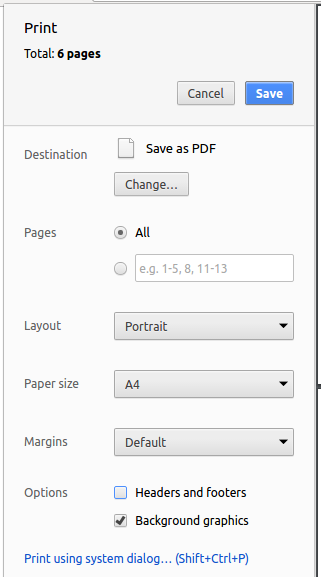
5.4. Site-wide Documentation Settings
The build.gradle file specifies some project-specific asciidoc attributes which affects how all documentation files within this project are rendered.
Attributes left unset in the build.gradle file will use their default value, if any.
|
| Attribute name | Description | Default value |
|---|---|---|
|
The name of the website. If set, the name will be displayed near the top of the page. |
not set |
|
URL to the site’s repository on GitHub. Setting this will add a "View on GitHub" link in the navigation bar. |
not set |
|
Define this attribute if the project is an official SE-EDU project. This will render the SE-EDU navigation bar at the top of the page, and add some SE-EDU-specific navigation items. |
not set |
5.5. Per-file Documentation Settings
Each .adoc file may also specify some file-specific asciidoc attributes which affects how the file is rendered.
Asciidoctor’s built-in attributes may be specified and used as well.
Attributes left unset in .adoc files will use their default value, if any.
|
| Attribute name | Description | Default value |
|---|---|---|
|
Site section that the document belongs to.
This will cause the associated item in the navigation bar to be highlighted.
One of: * Official SE-EDU projects only |
not set |
|
Set this attribute to remove the site navigation bar. |
not set |
5.6. Site Template
The files in docs/stylesheets are the CSS stylesheets of the site.
You can modify them to change some properties of the site’s design.
The files in docs/templates controls the rendering of .adoc files into HTML5.
These template files are written in a mixture of Ruby and Slim.
|
Modifying the template files in |
6. Testing
6.1. Running Tests
There are three ways to run tests.
| The most reliable way to run tests is the 3rd one. The first two methods might fail some GUI tests due to platform/resolution-specific idiosyncrasies. |
Method 1: Using IntelliJ JUnit test runner
-
To run all tests, right-click on the
src/test/javafolder and chooseRun 'All Tests' -
To run a subset of tests, you can right-click on a test package, test class, or a test and choose
Run 'ABC'
Method 2: Using Gradle
-
Open a console and run the command
gradlew clean allTests(Mac/Linux:./gradlew clean allTests)
| See UsingGradle.adoc for more info on how to run tests using Gradle. |
Method 3: Using Gradle (headless)
Thanks to the TestFX library we use, our GUI tests can be run in the headless mode. In the headless mode, GUI tests do not show up on the screen. That means the developer can do other things on the Computer while the tests are running.
To run tests in headless mode, open a console and run the command gradlew clean headless allTests (Mac/Linux: ./gradlew clean headless allTests)
6.2. Types of tests
We have two types of tests:
-
GUI Tests - These are tests involving the GUI. They include,
-
System Tests that test the entire App by simulating user actions on the GUI. These are in the
systemtestspackage. -
Unit tests that test the individual components. These are in
seedu.VolunCHeer.uipackage.
-
-
Non-GUI Tests - These are tests not involving the GUI. They include,
-
Unit tests targeting the lowest level methods/classes.
e.g.seedu.VolunCHeer.commons.StringUtilTest -
Integration tests that are checking the integration of multiple code units (those code units are assumed to be working).
e.g.seedu.VolunCHeer.storage.StorageManagerTest -
Hybrids of unit and integration tests. These test are checking multiple code units as well as how the are connected together.
e.g.seedu.VolunCHeer.logic.LogicManagerTest
-
6.3. Troubleshooting Testing
Problem: HelpWindowTest fails with a NullPointerException.
-
Reason: One of its dependencies,
HelpWindow.htmlinsrc/main/resources/docsis missing. -
Solution: Execute Gradle task
processResources.
7. Dev Ops
7.1. Build Automation
See UsingGradle.adoc to learn how to use Gradle for build automation.
7.2. Continuous Integration
We use Travis CI and AppVeyor to perform Continuous Integration on our projects. See UsingTravis.adoc and UsingAppVeyor.adoc for more details.
7.3. Coverage Reporting
We use Coveralls to track the code coverage of our projects. See UsingCoveralls.adoc for more details.
7.4. Documentation Previews
When a pull request has changes to asciidoc files, you can use Netlify to see a preview of how the HTML version of those asciidoc files will look like when the pull request is merged. See UsingNetlify.adoc for more details.
7.5. Making a Release
Here are the steps to create a new release.
-
Update the version number in
MainApp.java. -
Generate a JAR file using Gradle.
-
Tag the repo with the version number. e.g.
v0.1 -
Create a new release using GitHub and upload the JAR file you created.
7.6. Managing Dependencies
A project often depends on third-party libraries. For example, VolunCHeer Book depends on the Jackson library for JSON parsing. Managing these dependencies can be automated using Gradle. For example, Gradle can download the dependencies automatically, which is better than these alternatives:
-
Include those libraries in the repo (this bloats the repo size)
-
Require developers to download those libraries manually (this creates extra work for developers)
Appendix A: Product Scope
Target user profile:
-
manager of a volunteer organization such as shool’s CCAs, CIP office
-
has a need to manage significant number of volunteers but not attached exclusively to any other volunteering program
-
has a need to manage a significant number of interested beneficiaries who want to connect to the volunteers
-
has a need to manage multiple projects
-
prefer desktop apps over other types
-
can type fast
-
prefers typing over mouse input
-
is reasonably comfortable using CLI apps
Value proposition: * manage volunteers, beneficiaries, projects' details faster than a typical mouse/GUI driven app
Appendix B: User Stories
Priorities: High (must have) - * * *, Medium (nice to have) - * *, Low (unlikely to have) - *
| Priority | As a … | I want to … | So that I can… |
|---|---|---|---|
|
new user |
see usage instructions |
refer to instructions when I forget how to use the App |
|
volunteering project manager |
add a new volunteer |
have their information in the system to manage and distribute them |
|
volunteering project manager |
delete an existing volunteer |
remove the volunteer that no longer needs |
|
volunteering project manager |
edit a volunteer |
update information of volunteer |
|
volunteering project manager |
find a volunteer by name |
locate details of the volunteer without having to go through the entire list |
|
volunteering project manager |
hide private contact details by default |
minimize chance of someone else seeing them by accident |
|
volunteering project manager |
sort volunteer list by name |
locate a the volunteer easily |
|
volunteering project manager |
add a beneficiary |
have their infomation in the system to manage |
|
volunteering project manager |
add beneficiary’s description |
have a description of beneficiary to refer to |
`* ` |
volunteering project manager |
highlight details/ keywords in the beneficiary’s description |
read and scan through the information easily |
|
volunteering project manager |
delete a beneficiary |
remove beneficary |
|
volunteering project manager |
edit a beneficiary |
update details if there is any changes |
|
volunteering project manager |
sort the beneficiary by name or more |
easily manage the list of beneficiary |
|
volunteering project manager |
see the summary of beneficiary based on their activeness |
gain overview of beneficiaries to collaborate with or seek funding from |
|
volunteering project manager |
add a new project with specific details |
manage the project and allocate volunteers in the project |
|
volunteering project manager |
edit a project |
change details of the project if needed |
|
volunteering project manager |
delete a project |
remove projects that is abundant, cancelled or outdated |
|
volunteering project manager |
take attendance of volunteers for a project |
keep track of volunteers’s attendance |
|
volunteering project manager |
remind the most prioritised/ closed to dealine project |
remind me to work of pay special attention to that project’s progress |
|
volunteering project manager |
have a calendar of projects on the GUI |
easily visualize the timeline of work and projects |
|
volunteering project manager |
have a recommendation list of volunteer based on several factors |
easily adding relevant volunteers in a project |
|
volunteering project manager |
import, export data |
easily transfer the data to other machines to use |
|
volunteering project manager |
undo, redo |
go back to my preferred state if I make a mistake |
|
user |
have autofill function on command line |
type faster |
Appendix C: Use Cases
(For all use cases below, the System is the VolunCHeer and the Actor is the user, unless specified otherwise)
Use case 1: Delete volunteer
MSS
-
User requests to list volunteers
-
VolunCHeer shows a list of volunteers
-
User requests to delete a specific volunteer in the list
-
VolunCHeer deletes the volunteer
Use case ends.
Extensions
-
2a. The list is empty.
Use case ends.
-
3a. The given index is invalid.
-
3a1. VolunCHeer shows an error message.
Use case resumes at step 2.
-
Use case 2: Add volunteer
MSS
-
User requests to add a volunteer, including name, age, email, address, etc.
-
VolunCHeer shows the successful add message
Use case ends.
Extensions
-
2a. The volunteer has existed, show edit option
Use case ends.
-
3a. The given command line is invalid.
-
3a1. VolunCHeer shows an error message.
Use case ends.
-
Use case 3: Edit volunteer
MSS
-
Users requests to find a volunteer.
-
User requests to edit the volunteer.
-
VolunCHeer shows the successful edit message.
Use case ends.
Extensions
-
1a. The volunteer cannot be found
Use case ends.
-
2a. Given index for edit command is invalid.
-
2a1. VolunCHeer shows an error message.
Use case ends.
-
Use case 4: Add Project
MSS
-
Users requests to add a project.
-
VolunCHeer shows the successful add message.
Use case ends.
Extensions
-
2a. The command line is invalid.
-
2a1. VolunCHeer shows an error message.
Use case ends.
-
-
2b. The beneficiary is not existed.
-
2b1. VolunCHeer shows an error message.
-
-
2b. The date is invalid.
-
2b1. VolunCHeer shows an error message.
Use case ends.
-
-
2c. The project is existed.
-
2c1. VolunCHeer shows edit option.
Use case ends.
-
Use case 5: Edit Project
MSS
-
Users requests to edit a project.
-
VolunCHeer shows the successful edit message.
Use case ends.
Extensions
-
2a. The project is not existed.
-
2a1. VolunCHeer shows an error message.
Use case ends.
-
Use case 6: Find volunteer
MSS
-
Users requests to find (a) volunteer/volunteers by name.
-
VolunCHeer shows the list of volunteers who share the name.
Use case ends.
Extensions
-
2a. There is no volunteer with that name.
-
2a1. VolunCHeer returns an empty list.
Use case ends.
-
Use case 7: Delete Project
MSS
-
User requests to delete a specific project by name
-
VolunCHeer deletes the project
Use case ends.
Extensions
-
2a. project is not existed.
-
2a1. VolunCHeer shows an error message.
Use case ends.
-
Use case 8: export volunteer list
MSS
-
User requests to import a volunteer file
-
VolunCHeer imports the volunteer file to the volunteer list
Use case ends.
Extensions
-
2a. file cannot be found.
-
2a1. VolunCHeer shows an error message.
Use case ends.
-
Use case 9: export volunteer list
MSS
-
User requests to export a volunteer file
-
VolunCHeer exports new volunteer data file
Use case ends.
Extensions
-
2a. the file has existed.
-
2a1. VolunCHeer overwritten the file.
Use case ends.
-
Use case 10: export volunteer list
MSS
-
User requests to export a volunteer file
-
VolunCHeer exports new volunteer data file
Use case ends.
Extensions
-
2a. the file has existed.
-
2a1. VolunCHeer overwritten the file.
Use case ends.
-
Use case 11: Add a beneficiary
MSS
-
User requests to add a beneficiary.
-
VolunCHeer shows the successful add message
Use case ends.
Extensions
-
2a. The beneficiary has existed, show error message
Use case ends.
-
2b. The given command line is invalid.
-
2b1. VolunCHeer shows an error message.
Use case ends.
-
Use case 12: Edit a beneficiary
MSS
-
Users requests to edit a beneficiary.
-
VolunCHeer shows the successful edit message.
Use case ends.
Extensions
-
2a. The beneficiary is not existed.
-
2a1. VolunCHeer shows an error message.
Use case ends.
-
Use case 13: Delete a beneficiary (soft delete)
MSS
-
Users requests to delete a beneficiary.
-
VolunCHeer shows the successful delete message.
Use case ends.
Extensions
-
2a. The beneficiary is not existed.
-
2a1. VolunCHeer shows an error message.
Use case ends.
-
-
2b. The beneficiary has attached projects.
-
2b1. VolunCHeer shows an error message.
Use case ends.
-
Use case 14: Sort volunteers based on PRIORITY_SCORE
MSS
-
User uses "map" command to calculate PRIORITY_SCORE.
-
User requests to make a sorted list of volunteers based on PRIORITY_SCORE.
-
VolunCHeer shows the successful sorted list.
Use case ends.
Extensions
-
2a. Invalid map features.
-
2b1. VolunCHeer shows error message. Use case ends.
-
Appendix D: Non Functional Requirements
-
Should work on any mainstream OS as long as it has Java
9or higher installed. -
Should be able to hold up to 1000 volunteers without a noticeable sluggishness in performance for typical usage.
-
A user with above average typing speed for regular English text (i.e. not code, not system admin commands) should be able to accomplish most of the tasks faster using commands than using the mouse.
Appendix F: Product Survey
VolunCHeer
Author: …
Pros:
-
…
-
…
Cons:
-
…
-
…
Appendix G: Instructions for Manual Testing
Given below are instructions to test the app manually.
| These instructions only provide a starting point for testers to work on; testers are expected to do more exploratory testing. |
G.1. Launch and Shutdown
-
Initial launch
-
Download the jar file and copy into an empty folder
-
Double-click the jar file
Expected: Shows the GUI with a set of sample contacts. The window size may not be optimum.
-
-
Saving window preferences
-
Resize the window to an optimum size. Move the window to a different location. Close the window.
-
Re-launch the app by double-clicking the jar file.
Expected: The most recent window size and location is retained.
-
{ more test cases … }
G.2. Deleting a volunteer
-
Deleting a volunteer while all volunteers are listed
-
Prerequisites: List all volunteers using the
listcommand. Multiple volunteers in the list. -
Test case:
deleteVolunteer 1
Expected: First contact is deleted from the list. Details of the deleted contact shown in the status message. Timestamp in the status bar is updated. -
Test case:
deleteVolunteer 0
Expected: No volunteer is deleted. Error details shown in the status message. Status bar remains the same. -
Other incorrect delete commands to try:
deleteVolunteer,deleteVolunteer x(where x is larger than the list size) {give more}
Expected: Similar to previous.
-
{ more test cases … }
G.3. Saving data
-
Dealing with missing/corrupted data files
-
{explain how to simulate a missing/corrupted file and the expected behavior}
-
{ more test cases … }